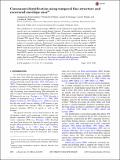Consonant identification using temporal fine structure and recovered envelope cues
Author(s)
Swaminathan, Jayaganesh; Reed, Charlotte M.; Desloge, Joseph G.; Braida, Louis D.; Delhorne, Lorraine A.
DownloadBraida_Consonant identification.pdf (1.079Mb)
PUBLISHER_POLICY
Publisher Policy
Article is made available in accordance with the publisher's policy and may be subject to US copyright law. Please refer to the publisher's site for terms of use.
Terms of use
Metadata
Show full item recordAbstract
The contribution of recovered envelopes (RENVs) to the utilization of temporal-fine structure (TFS) speech cues was examined in normal-hearing listeners. Consonant identification experiments used speech stimuli processed to present TFS or RENV cues. Experiment 1 examined the effects of exposure and presentation order using 16-band TFS speech and 40-band RENV speech recovered from 16-band TFS speech. Prior exposure to TFS speech aided in the reception of RENV speech. Performance on the two conditions was similar (∼50%-correct) for experienced listeners as was the pattern of consonant confusions. Experiment 2 examined the effect of varying the number of RENV bands recovered from 16-band TFS speech. Mean identification scores decreased as the number of RENV bands decreased from 40 to 8 and were only slightly above chance levels for 16 and 8 bands. Experiment 3 examined the effect of varying the number of bands in the TFS speech from which 40-band RENV speech was constructed. Performance fell from 85%- to 31%-correct as the number of TFS bands increased from 1 to 32. Overall, these results suggest that the interpretation of previous studies that have used TFS speech may have been confounded with the presence of RENVs.
Date issued
2014-04Department
Massachusetts Institute of Technology. Department of Electrical Engineering and Computer Science; Massachusetts Institute of Technology. Research Laboratory of ElectronicsJournal
The Journal of the Acoustical Society of America
Publisher
Acoustical Society of America (ASA)
Citation
Swaminathan, Jayaganesh, Charlotte M. Reed, Joseph G. Desloge, Louis D. Braida, and Lorraine A. Delhorne. “Consonant Identification Using Temporal Fine Structure and Recovered Envelope Cuesa).” J. Acoust. Soc. Am. 135, no. 4 (April 2014): 2078–2090. © 2014 Acoustical Society of America
Version: Final published version
ISSN
0001-4966